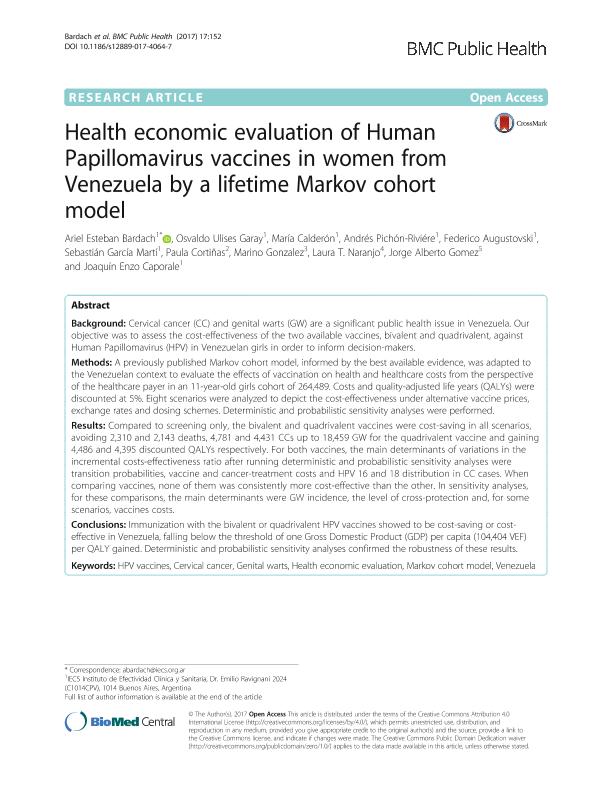Mostrar el registro sencillo del ítem
dc.contributor.author
Bardach, Ariel Esteban

dc.contributor.author
Garay, Osvaldo Ulises
dc.contributor.author
Calderón, María
dc.contributor.author
Pichón-riviere, Andres

dc.contributor.author
Augustovski, Federico Ariel

dc.contributor.author
García Martí, Sebastián

dc.contributor.author
Cortiñas, Paula
dc.contributor.author
Gonzalez, Marino
dc.contributor.author
Naranjo, Laura T.
dc.contributor.author
Gomez, Jorge Alberto
dc.contributor.author
Caporale, Joaquín Enzo
dc.date.available
2018-04-03T16:24:12Z
dc.date.issued
2017-02
dc.identifier.citation
Bardach, Ariel Esteban; Garay, Osvaldo Ulises; Calderón, María; Pichón-riviere, Andres; Augustovski, Federico Ariel; et al.; Health economic evaluation of Human Papillomavirus vaccines in women from Venezuela by a lifetime Markov cohort model; BioMed Central; Bmc Public Health; 17; 1; 2-2017; 1-15
dc.identifier.issn
1471-2458
dc.identifier.uri
http://hdl.handle.net/11336/40497
dc.description.abstract
Background: Cervical cancer (CC) and genital warts (GW) are a significant public health issue in Venezuela. Our objective was to assess the cost-effectiveness of the two available vaccines, bivalent and quadrivalent, against Human Papillomavirus (HPV) in Venezuelan girls in order to inform decision-makers. Methods: A previously published Markov cohort model, informed by the best available evidence, was adapted to the Venezuelan context to evaluate the effects of vaccination on health and healthcare costs from the perspective of the healthcare payer in an 11-year-old girls cohort of 264,489. Costs and quality-adjusted life years (QALYs) were discounted at 5%. Eight scenarios were analyzed to depict the cost-effectiveness under alternative vaccine prices, exchange rates and dosing schemes. Deterministic and probabilistic sensitivity analyses were performed. Results: Compared to screening only, the bivalent and quadrivalent vaccines were cost-saving in all scenarios, avoiding 2,310 and 2,143 deaths, 4,781 and 4,431 CCs up to 18,459 GW for the quadrivalent vaccine and gaining 4,486 and 4,395 discounted QALYs respectively. For both vaccines, the main determinants of variations in the incremental costs-effectiveness ratio after running deterministic and probabilistic sensitivity analyses were transition probabilities, vaccine and cancer-treatment costs and HPV 16 and 18 distribution in CC cases. When comparing vaccines, none of them was consistently more cost-effective than the other. In sensitivity analyses, for these comparisons, the main determinants were GW incidence, the level of cross-protection and, for some scenarios, vaccines costs. Conclusions: Immunization with the bivalent or quadrivalent HPV vaccines showed to be cost-saving or cost-effective in Venezuela, falling below the threshold of one Gross Domestic Product (GDP) per capita (104,404 VEF) per QALY gained. Deterministic and probabilistic sensitivity analyses confirmed the robustness of these results.
dc.format
application/pdf
dc.language.iso
eng
dc.publisher
BioMed Central

dc.rights
info:eu-repo/semantics/openAccess
dc.rights.uri
https://creativecommons.org/licenses/by-nc-sa/2.5/ar/
dc.subject
Cervical Cancer
dc.subject
Genital Warts
dc.subject
Health Economic Evaluation
dc.subject
Hpv Vaccines
dc.subject
Markov Cohort Model
dc.subject
Venezuela
dc.subject.classification
Salud Ocupacional

dc.subject.classification
Ciencias de la Salud

dc.subject.classification
CIENCIAS MÉDICAS Y DE LA SALUD

dc.title
Health economic evaluation of Human Papillomavirus vaccines in women from Venezuela by a lifetime Markov cohort model
dc.type
info:eu-repo/semantics/article
dc.type
info:ar-repo/semantics/artículo
dc.type
info:eu-repo/semantics/publishedVersion
dc.date.updated
2018-03-27T20:00:29Z
dc.journal.volume
17
dc.journal.number
1
dc.journal.pagination
1-15
dc.journal.pais
Reino Unido

dc.journal.ciudad
Londres
dc.description.fil
Fil: Bardach, Ariel Esteban. Consejo Nacional de Investigaciones Científicas y Técnicas; Argentina. Instituto de Efectividad Clínica y Sanitaria; Argentina
dc.description.fil
Fil: Garay, Osvaldo Ulises. Instituto de Efectividad Clínica y Sanitaria; Argentina
dc.description.fil
Fil: Calderón, María. Instituto de Efectividad Clínica y Sanitaria; Argentina
dc.description.fil
Fil: Pichón-riviere, Andres. Instituto de Efectividad Clínica y Sanitaria; Argentina
dc.description.fil
Fil: Augustovski, Federico Ariel. Instituto de Efectividad Clínica y Sanitaria; Argentina
dc.description.fil
Fil: García Martí, Sebastián. Instituto de Efectividad Clínica y Sanitaria; Argentina
dc.description.fil
Fil: Cortiñas, Paula. Salud Chacao; Venezuela
dc.description.fil
Fil: Gonzalez, Marino. Universidad Simon Bolivar; Venezuela
dc.description.fil
Fil: Naranjo, Laura T.. GlaxoSmithKline Biologicals; Panamá
dc.description.fil
Fil: Gomez, Jorge Alberto. GSK Vaccines Latin America; Argentina
dc.description.fil
Fil: Caporale, Joaquín Enzo. Instituto de Efectividad Clínica y Sanitaria; Argentina
dc.journal.title
Bmc Public Health

dc.relation.alternativeid
info:eu-repo/semantics/altIdentifier/doi/http://dx.doi.org/10.1186/s12889-017-4064-7
dc.relation.alternativeid
info:eu-repo/semantics/altIdentifier/url/https://bmcpublichealth.biomedcentral.com/articles/10.1186/s12889-017-4064-7
Archivos asociados
